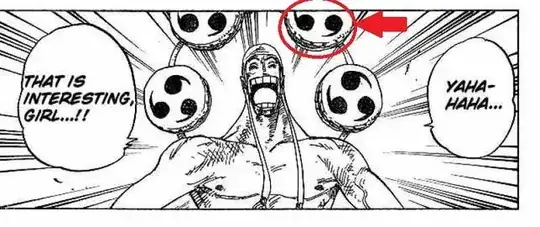Enel, God of Thunder, or of anything, usually has multiple copies of a thing behind his back.

What is that thing? Did he transplant it inside his body?
Enel, God of Thunder, or of anything, usually has multiple copies of a thing behind his back.

What is that thing? Did he transplant it inside his body?
If you have a look at the Appearance section of Enel's wiki page, you can see that (emphasis mine)
Enel is a tall, muscular man who has white/blond hair which was, in ancient South American civilizations, considered godly..
His nose has many lines running horizontally across it. His ear lobes are extremely long, ending up to his torso. He also holds four large Tomoe drums attached via a large ring to his back, instead of the regular Skypiean/Birkan wings, which gives him an appearance similar to a Raijin, a similarity made even more prominent when using his "200,000,000 Volt Amaru" transformation.
So they are basically just external features of his attire and not really something which he has transplanted to his body.
I don't watch One Piece, so this may be completely off-base, but.
Given that Enel is a god of thunder, and given that he has that thing around his head, it is plausible that his appearance is an allusion to some depictions of Taishakuten (a.k.a. Shakra/Sakka, a.k.a. Indra). As Indra, he is a god of thunder in Hinduism (and in pre-Trimurti Vedic religion, the chief god of the pantheon), and he was later loosely adopted into Buddhism as Shakra. As Shakra, he is sometimes (not sure how often) depicted with a wheel behind his head that looks similar to the thing behind Enel's head:
They're taiko drums, explicitly called such in the manga. Nami shouts in chapter 276 (first chapter of volume 30), "The taiko drum is turning into a bird?!" (Haha, that sounds silly without context.)
They appear to be transplanted into his body. There are some points where you can see his back, and they just go into his back. The first frame of 276 is a good reference, coincidentally.
*Since the wiki pages are made by fans, I don't use them as hard reference, just starting points and a "maybe this is correct" guideline. The "tomoe" appears to be the design on the drums.